
The 45th Infantry Division
World War II Congressional Medal of Honor Recipients
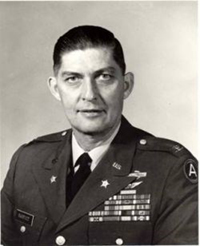
Van T. Barfoot (image courtesy of the 45th Infantry Division).
Van T. Barfoot (Choctaw)
Rank and organization: Second Lieutenant, US Army, 157th Infantry Regiment, 45th Infantry Division.
Place and date: Near Carano, Italy, 23 May 1944.
Medal Citation:
For conspicuous gallantry and intrepidity at the risk of life above and beyond the call of duty on 23 May 1944, near Carano, Italy. With his platoon heavily engaged during an assault against forces well entrenched on commanding ground, 2d Lt. Barfoot (then Tech. Sgt.) moved off alone upon the enemy left flank. He crawled to the proximity of 1 machinegun nest and made a direct hit on it with a hand grenade, killing 2 and wounding 3 Germans. He continued along the German defense line to another machinegun emplacement, and with his tommy gun killed 2 and captured 3 soldiers. Members of another enemy machinegun crew then abandoned their position and gave themselves up to Sgt. Barfoot. Leaving the prisoners for his support squad to pick up, he proceeded to mop up positions in the immediate area, capturing more prisoners and bringing his total count to 17. Later that day, after he had reorganized his men and consolidated the newly captured ground, the enemy launched a fierce armored counterattack directly at his platoon positions. Securing a bazooka, Sgt. Barfoot took up an exposed position directly in front of 3 advancing Mark VI tanks. From a distance of 75 yards his first shot destroyed the track of the leading tank, effectively disabling it, while the other 2 changed direction toward the flank. As the crew of the disabled tank dismounted, Sgt. Barfoot killed 3 of them with his tommy gun. He continued onward into enemy terrain and destroyed a recently abandoned German fieldpiece with a demolition charge placed in the breech. While returning to his platoon position, Sgt. Barfoot, though greatly fatigued by his Herculean efforts, assisted 2 of his seriously wounded men 1,700 yards to a position of safety. Sgt. Barfoot's extraordinary heroism, demonstration of magnificent valor, and aggressive determination in the face of pointblank fire are a perpetual inspiration to his fellow soldiers.
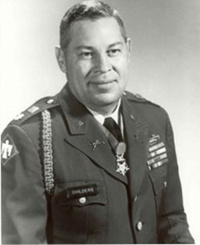
Ernest Childers (image courtesy of the 45th Infantry Division).
Ernest Childers (Muscogee (Creek))
Rank and Organization:
Second Lieutenant, US Army, 180th Infantry Regiment, 45th Infantry Division.
Place and Date: Oliveto, Italy, 22 September 1943.
Medal Citation:
For conspicuous gallantry and intrepidity at risk of life above and beyond the call of duty in action on 22 September 1943, at Oliveto, Italy. Although 2d Lt. Childers previously had just suffered a fractured instep he, with 8 enlisted men, advanced up a hill toward enemy machinegun nests. The group advanced to a rock wall overlooking a cornfield and 2d Lt. Childers ordered a base of fire laid across the filed so that he could advance. When he was fired upon by 2 enemy snipers from a nearby house he killed both of them. He moved behind the machine gun nests and killed all occupants of the nearer one. He continued toward the second one and threw rocks into it. When the 2 occupants of the nest raised up, he shot 1. The other was killed by 1 of the 8 enlisted men, 2d Lt. Childers continued his advance toward a house farther up the hill, and single handed, captured an enemy mortar observer. The exceptional leadership, initiative, calmness under fire, and conspicuous gallantry displayed by 2d Lt. Childers were an inspiration to his men.

Almond E. Fisher (image courtesy of the 45th Infantry Division).
Almond E. Fisher
Rank and organization: Second Lieutenant, US Army, Company E, 157th Infantry Regiment, 45th Infantry Division.
Place and date: Near Grammont, France, 12–13 September 1944.
Medal Citation:
For conspicuous gallantry and intrepidity at the risk of his life above and beyond the call of duty on the night of 12-13 September 1944, near Grammont, France. In the darkness of early morning, 2nd Lt. Fisher was leading a platoon of Company E, 157th Infantry, in a single column to the attack of a strongly defended hill position. At 2:30 A.M., the forward elements were brought under enemy machinegun fire from a distance not more than 20 yards. Working his way alone to within 20 feet of the gun emplacement, he opened fire with his carbine and killed the entire gun crew. A few minutes after the advance was resumed, heavy machinegun fire was encountered from the left flank. Again crawling forward alone under withering fire, he blasted the gun and crew from their positions with hand grenades. After a halt to replenish ammunition, the advance was again resumed and continued for 1 hour before being stopped by intense machinegun and rifle fire. Through the courageous and skillful leadership of 2nd Lt. Fisher, the pocket of determined enemy resistance was rapidly obliterated. Spotting an emplaced machine pistol a short time later, with 1 of his men he moved forward and destroyed the position. As the advance continued the fire fight became more intense. When a bypassed German climbed from his foxhole and attempted to tear an M1 rifle from the hand of 1 of his men, 2d Lt. Fisher whirled and killed the enemy with a burst from his carbine. About 30 minutes later the platoon came under the heavy fire of machineguns from across an open filed. 2d Lt. Fisher, disregarding the terrific fire, moved across the field with no cover or concealment to within range, knocked the gun from the position and killed or wounded the crew. Still under heavy fire he returned to his platoon and continued the advance. Once again heavy fire was encountered from a machinegun directly in front. Calling for hand grenades, he found only 2 remaining in the entire platoon. Pulling the pins and carrying a grenade in each hand, he crawled toward the gun emplacement, moving across areas devoid of cover and under intense fire to within 15 yards when he threw the grenades, demolished the gun and killed the gun crew. With ammunition low and daybreak near, he ordered his men to dig in and hold the ground already won. Under constant fire from the front and from both flanks, he moved among them directing the preparations for the defense. Shortly after the ammunition supply was replenished, the Germans launched a last determined effort against the depleted group. Attacked by superior numbers from the front, right, and left flank, and even from the rear, the platoon, in bitter hand-to-hand engagements drove back the enemy at every point. Wounded in both feet by close-range machine pistol fire early in the battle, 2d Lt. Fisher refused medical attention. Unable to walk, he crawled from man to man encouraging them and checking each position. Only after the fighting had subsided did 2d Lt. Fisher crawl 300 yards to the aid station from which he was evacuated. His extraordinary heroism, magnificent valor, and aggressive determination in the face of pointblank enemy fire is an inspiration to his organization and reflects the finest traditions of the U.S. Armed Forces.

William J. Johnston (image courtesy of the 45th Infantry Division).
William J. Johnston
Rank and organization: Private First Class, US Army, Company G, 180th Infantry, 45th Infantry Division.
Place and date: Near Padiglione, Italy, 17–19 February 1944.
Medal Citation:
For conspicuous gallantry and intrepidity at risk of life above and beyond the call of duty in action against the enemy. On 17 February 1944, near Padigilone, Italy, he observed and fired upon an attacking force of approximately 80 Germans, causing at least 25 casualties and forcing withdrawal of the remainder. All that day he manned his gun without relief, subject to mortar, artillery, and sniper fire. Two Germans individually worked so close to his position that his machinegun was ineffective, whereupon he killed 1 with his pistol, the second with a rifle taken from another solider. When a rifleman protecting his gun position was killed by a sniper, he immediately moved the body and relocated the machinegun in that spot in order to obtain a better field of fire. He volunteered to cover the platoon's withdrawal and was the last man to leave that night. In his new position he maintained an all night vigil, the next day causing 7 German casualties. On the afternoon of the 18th, the organization on the left flank having been forced to withdraw, he again covered the withdrawal of his own organization. Shortly thereafter, he was seriously wounded over the heart, and a passing soldier saw him trying to crawl up the embankment. The soldier aided him to resume his position behind the machine gun which was soon heard in action for about 10 minutes. Though reported killed, PFC Johnston was seen returning to the American lines on the morning of 19 February slowly and painfully working his way back from his overrun position through enemy lines. He gave valuable information of new enemy dispositions. His heroic determination to destroy the enemy and disregard of his own safety aided immeasurably in halting a strong enemy attack, caused in enormous amount of enemy casualties, and so inspired his fellow soldiers that they fought for and held a vitally important position against greatly superior forces.
Salvador J. Lara
Rank and organization: Private First Class, US Army, Company L, 180th Infantry, 45th Infantry Division
Place and date: Aprilia, Italy, 27–28 May 1944
Medal Citation:
Private First Class Salvador J. Lara distinguished himself by acts of gallantry and intrepidity above and beyond the call of duty while serving as the Squad Leader of a rifle squad with 2d Platoon, Company L, 180th Infantry, 45th Infantry Division during combat operations against an armed enemy in Aprilia, Italy on May 27 and 28, 1944. On the afternoon of the 27th, Private First Class Lara aggressively led his rifle squad in neutralizing multiple enemy strongpoints and in inflicting large numbers of casualties on the enemy. Having taken his initial objective, Private First Class Lara noticed that the unit to his right was meeting stiff resistance from a large, well-entrenched enemy force in a deep ditch. Private First Class Lara quickly gathered three men and attacked a wide section of the enemy position, killing four, forcing fifteen others to surrender and causing two enemy mortar crews to abandon their weapons. His fearless and efficient performance enabled both his own unit and the unit to his right to continue to their objective. The next morning, as his company resumed the attack, Private First Class Lara sustained a severe leg wound, but did not stop to receive first aid. His company suffered heavy casualties as a result of withering machinegun fire coming from an enemy strongpoint on the right flank. After requesting permission to destroy the enemy machineguns armed only with a Browning Automatic Rifle, Private First Class Lara crawled alone toward the nearest machinegun. Despite his painful wound and the extreme danger of the task, he rose and fearlessly charged the nest, killing the crew members. Another machinegun opened fire on him, but he quickly neutralized this weapon with accurate fire from his Browning, killing three more of the enemy. His aggressive attack forced two other machinegun crews to flee their weapons. After rejoining his company, Private First Class Lara continued his exemplary performance until he captured his objective. Private First Class Lara’s extraordinary heroism and selflessness above and beyond the call of duty are in keeping with the highest traditions of military service and reflect great credit upon himself, his unit and the United States Army.

Jack C. Montgomery (image courtesy of the 45th Infantry Division).
Jack C. Montgomery (Cherokee)
Rank and organization: First Lieutenant, US Army, 45th Infantry Division.
Place and Date: Near Padiglione, Italy, 22 February 1944.
Medal Citation:
For conspicuous gallantry and intrepidity at risk of life above and beyond the call of duty on 22 February 1944, near Padiglione, Italy. Two hours before daybreak a strong force of enemy infantry established themselves in 3 echelons at 50 yards, 100 yards, and 300 yards respectively, in front of the rifle platoons commanded by 1st Lt. Montgomery. The closest position, consisting of 4 machineguns and 1 mortar, threatened the immediate security of the platoon position. Seizing an M1 rifle and several hand grenades, 1st Lt. Montgomery crawled up a ditch to within hand grenade range of the enemy. Then climbing boldly onto a little mound, he fired his rifle and threw his grenades so accurately that he killed 8 of the enemy and captured the remaining 4. Returning to his platoon, he called for artillery fire on a house, in and around which he suspected that the majority of the enemy had entrenched themselves. Arming himself with a carbine, he proceeded along the shallow ditch, as withering fire from the riflemen and machine gunners in the second position was concentrated on him. He attacked this position with such fury that 7 of the enemy surrendered to him, and both machineguns were silenced. Three German dead were found in the vicinity later that morning. 1st Lt. Montgomery continued boldly toward the house, 300 yards from his platoon position. It was now daylight, and the enemy observation was excellent across the flat open terrain which led to 1st Lt. Montgomery's objective. When the artillery barrage had lifted, 1st Lt. Montgomery ran fearlessly toward the strongly defended position. As the enemy started streaming out of the house, 1st Lt. Montgomery unafraid of treacherous snipers, expose himself daringly to assemble the surrendering enemy and send them to the rear. His fearless, aggressive, and intrepid actions that morning, accounted for a total of 11 enemy dead, 32 prisoners, and an unknown number of wounded. That night, while aiding an adjacent unit to repulse a counterattack, he was struck by mortar fragments, and seriously wounded. The selflessness and courage exhibited by 1st Lt. Montgomery in alone attacking 3 strong enemy positions inspired his men to a degree beyond estimation.
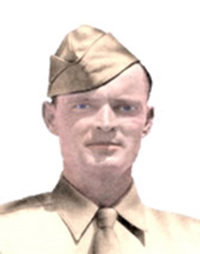
James D. Slanton (image courtesy of the 45th Infantry Division).
James D. Slaton
Rank and organization: Corporal, US Army, 157 Infantry, 45th Infantry Division.
Place and date: Near Oliveto, Italy.
Medal Citation:
For conspicuous gallantry and intrepidity at the risk of life above and beyond the call of duty in action with the enemy in the vicinity of Oliveto, Italy, on 23 September 1943. Cpl. Slaton was lead scout of an infantry squad which had been committed to a flank to knock out enemy resistance which had succeeded in pinning 2 attacking platoons to the ground. Working ahead of his squad, Cpl Slaton crept upon an enemy machinegun nest and, assaulting it with his bayonet, succeeded in killing the gunner. When his bayonet stuck, he detached it from the rifle and killed another gunner with rifle fire. At that time he was fired upon by a machine gun to his immediate left. Cpl. Slaton then moved over open ground under constant fire to within throwing distance, and on his second try scored a direct his on the second enemy machinegun nest, killing 2 enemy gunners. At that time a third machinegun fired on him 100 yards to his front, and Cpl. Slaton killed both of these enemy gunners with rifle fire. As a result of Cpl. Slaton's heroic action in immobilizing 3 enemy machinegun nests with bayonet, grenade, and rifle fire, the 2 rifle platoons which were receiving heavy casualties from enemy fire were enabled to withdraw to covered positions and again take the initiative. Cpl. Slaton withdrew under mortar fire on order of his platoon leader at dusk that evening. The heroic action of Cpl. Slaton were far above the call of duty and are worthy of emulation.
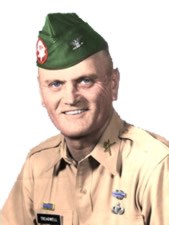
Jack Treadwell (image courtesy of the 45th Infantry Division).
Jack Treadwell
Rank and organization: Captain, US Army, Company F, 180th Infantry, 45th Infantry Division.
Place and date: Near Nieder-Wurzbach, Germany, 18 March 1945.
Medal Citation:
Capt. Treadwell (then 1st Lt.), commanding officer of Company F, near Nieder-Wurzbach, Germany, in the Siegfried line, single-handedly captured 6 pillboxes and 18 prisoners. Murderous enemy automatic and rifle fire with intermittent artillery bombardments had pinned down his company for hours at the base of a hill defended by concrete fortifications and interlocking trenches. Eight men sent to attack a single point had all become casualties on the bear slope when Capt Treadwell, armed with a machinegun and hand grenades, went forward alone to clear the way for his stalled company. Over the terrain devoid of cover and swept by bullets, he fearlessly advanced, firing at the aperture of the nearest pillbox, and when within range, hurling grenades at it. He reached the pillbox, thrust the muzzle of his gun through the port, and drove 4 Germans out with their hands in the air. A fifth was found dead inside. Waving these prisoners back to the American line, he continued under terrible, concentrated fire to the next pillbox, and took it in the same manner. In this fort he captured the commander of the hill defenses, whom he sent to the rear with the other prisoners. Never slacking his attack, he then ran across the crest of the hill to a third pillbox, traversing this distance in full view of hostile machine gunners and snipers. He was again successful in taking the enemy position. The Germans quickly fell prey to his further rushes on 3 more pillboxes in the confusion and havoc caused by his whirlwind as-saults and capture of their commander. Inspired by electrifying performance of their leader, the men of Company F stormed after him and overwhelmed resistance on the entire hill, driving a wedge into the Siegfried line and making it possible for their battalion to take its objective. By his courageous willingness to face nearly impossible odds and by his overwhelming one-man offensive, Capt. Treadwell reduced a heavily fortified, seemingly impregnable enemy sector.
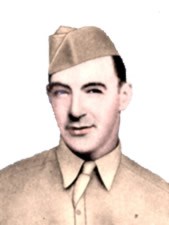
Edward G. Wilkin (image courtesy of the 45th Infantry Division).
Edward G. Wilkin
Rank and organization: Corporal, US Army, Company C 157th Infantry, 45th Infantry Division,
Place and date: Siegfried Line in German, 18 March 1945.
Medal Citation:
He spearheaded his unit's assault of the Siegfried line in Germany. Heavy fire from enemy riflemen and camouflaged pillboxes had pinned down his comrades when he moved forward on his own initiative to reconnoiter a route of advance. He cleared the way into an area studded with pillboxes, where he repeatedly stood up and walked into vicious enemy fire, storming 1 fortification after another with automatic rifle fire and grenades, killing enemy troops, taking prisoners as the enemy defense became confused, and encouraging his comrades by his heroic example. When halted by heavy barbed wire entanglements, he secured bangalore torpedoes and blasted a path toward still more pillboxes, all the time braving bursting grenades and mortar shells and direct rifle and automatic-weapons fire. He engaged in fierce fire fight, standing in the open while his adversaries fought from the protection of concrete emplacements, and on 1 occasion pursued enemy soldiers across an open field and through interlocking trenches, disregarding the crossfire from 2 pillboxes until he had penetrated the formidable line 200 yards in advance of any American element. That night, although terribly fatigued, he refused to rest and insisted on distributing rations and supplies to his comrades. Hearing that a nearby company was suffering heavy casualties, he secured permission to guide litter bearers and assist them in evacuating the wounded. All that night he remained in the battle area on his mercy missions, and for the following 2 days he continued to remove casualties, venturing into enemy-held territory, scorning cover and braving devastating mortar and artillery bombardments. In 3 days he neutralized and captured 6 pillboxes single-handedly, killed at least 9 Germans, wounded 13 took 13 prisoners, aided in the capture of 14 others, and saved many American lives by his fearless performance as a litter bearer. Through his superb fighting skill, dauntless courage, and gallant, inspiring actions, Cpl Wilkin contributed in large measure to his company's success in cracking the Siegfried Line. One month later he was killed in action while fighting deep in Germany.

